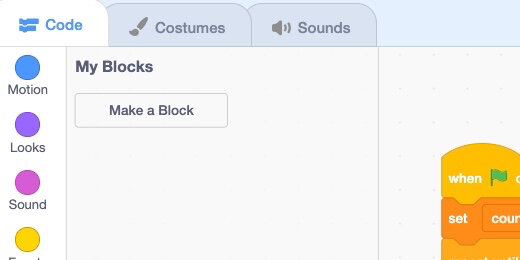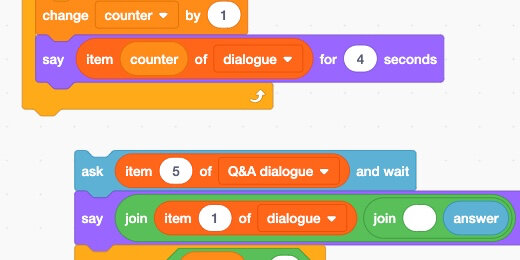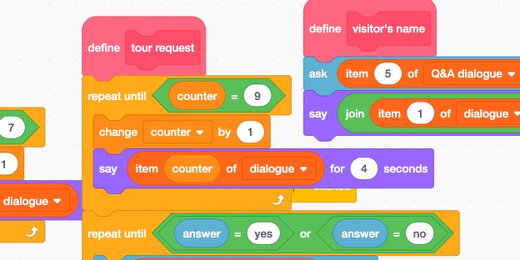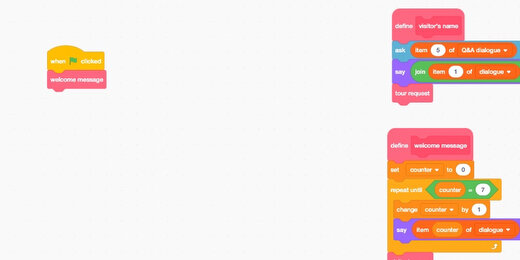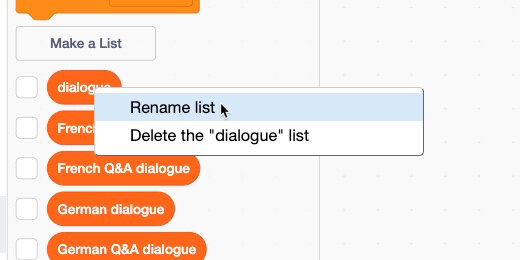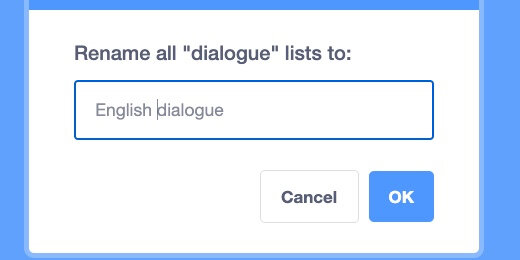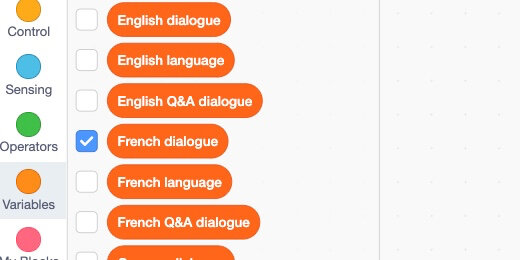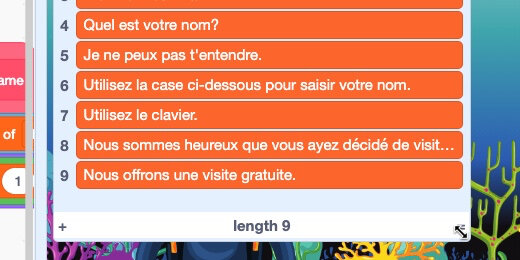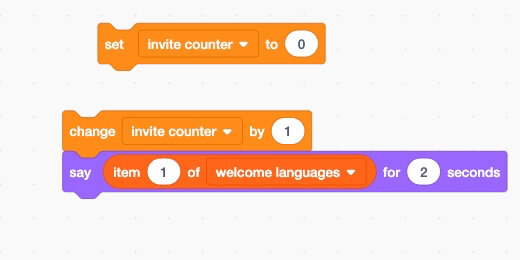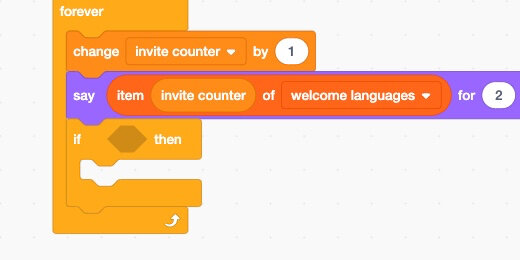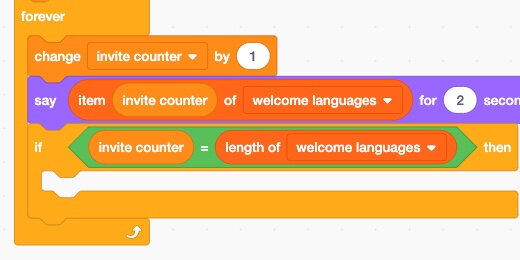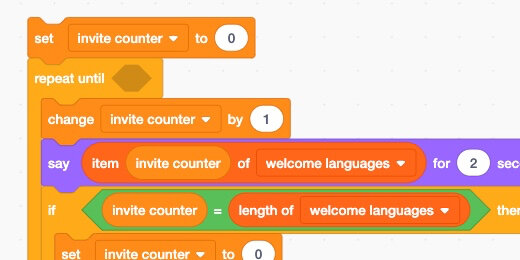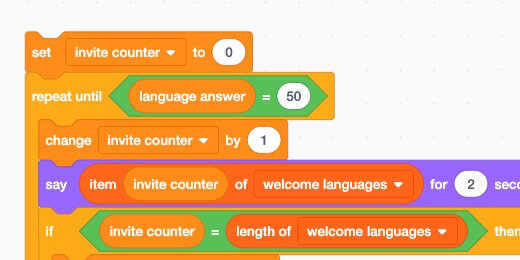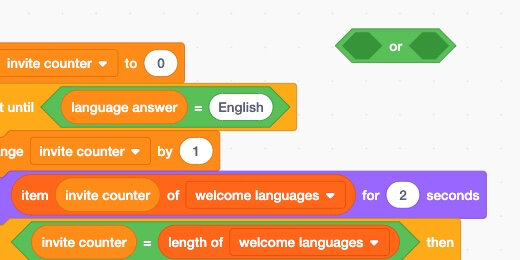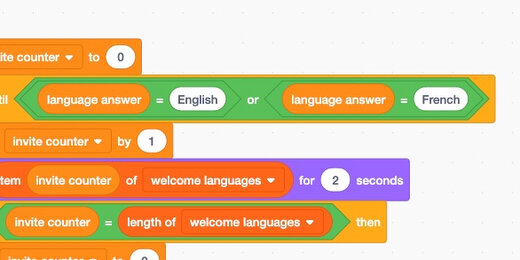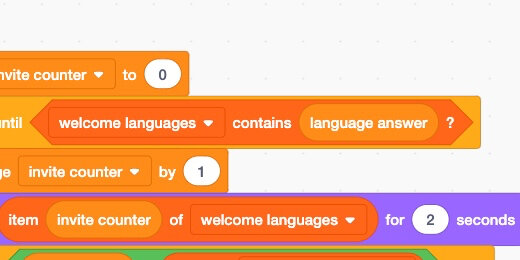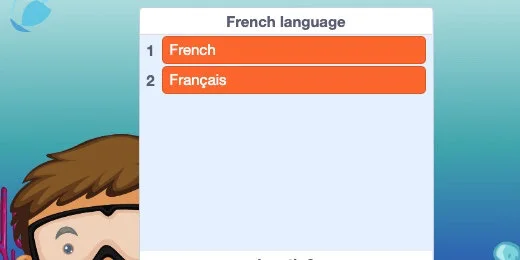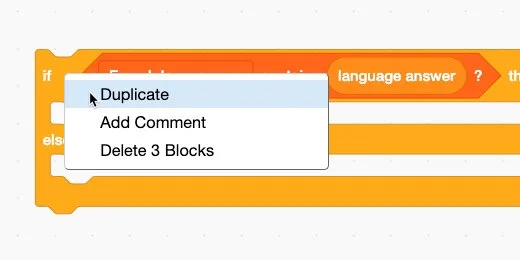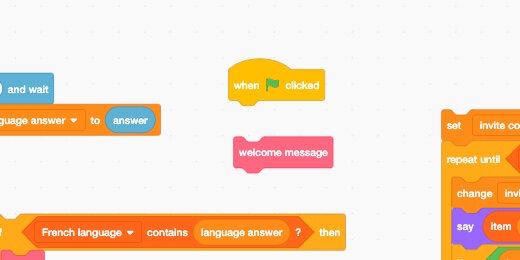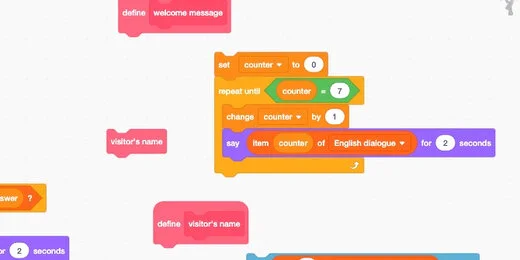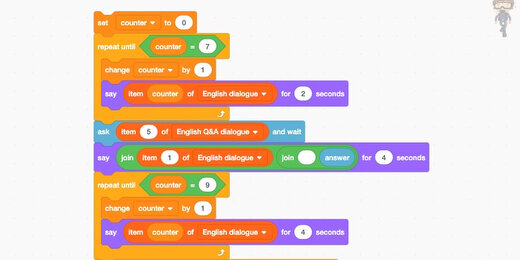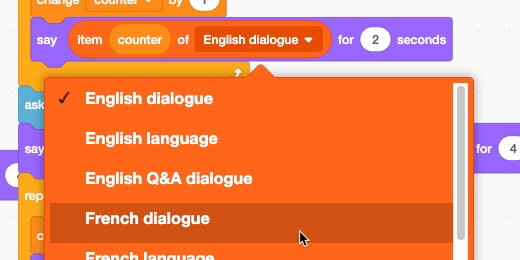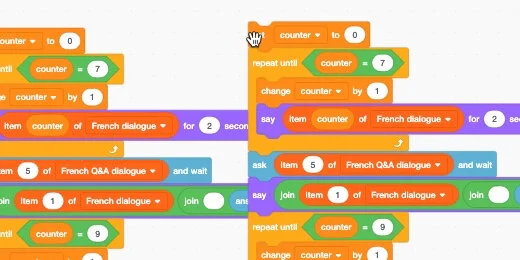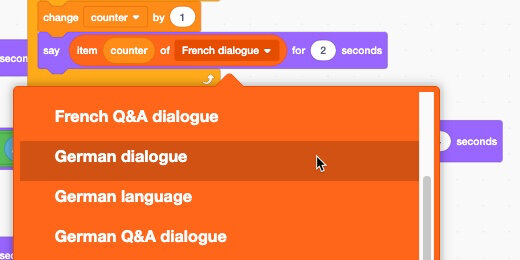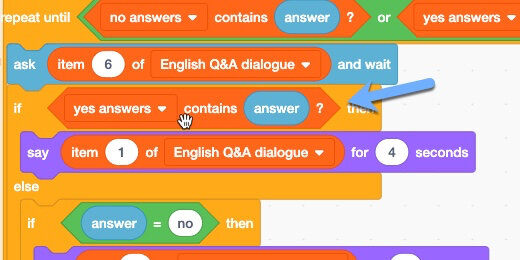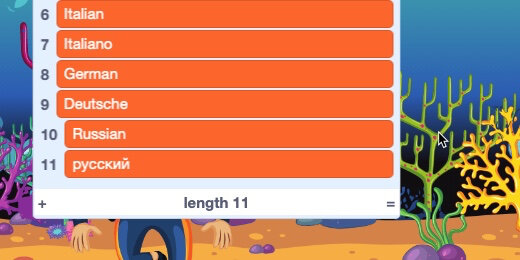Multiple language dialogue in Scratch projects
Scratch for multiple language dialogue
In this lesson, we are expanding on a previous lesson. In that lesson, we used lists to cycle through dialogue. That project is available through the link below. Make a copy of the project for use in this lesson.
https://scratch.mit.edu/projects/470830122
Click the flag to go through the project. The diver cycles through dialogue. The dialogue is stored in a list. A loop is used to call each dialogue item in the list. A separate list is used for the question and answer portion of the dialogue.
The upcoming lesson extends the use of lists to create dialogue in different languages. The lesson underscores the effectiveness and usability of lists in projects. Lists are useful in reducing the number of lines of code used in a project.
I encourage you to go through the lesson on dialogue and lists. Use the link below to access that lesson.
Stories and interactive projects with lists
Project resources
In this project, we use several lists for several languages. The link below is for a Zip file with several text files. The text files contain the dialogue used in the project for multiple languages. The language options include English, French, Italian, Spanish, and German. Use the link to download the text files. The files are in a ZIP folder. Extract the files from the folder.
Use the link above to get a copy of the project created up to this point. The link is available below for your convenience.
https://scratch.mit.edu/projects/470830122
My blocks
An essential part of code development is the use of Functions. Functions organize groups of tasks. The code we have up to now has two portions. The first part of the program begins with a dialogue. The second part contains questions and responses. We can divide this portion into one where we prompt for the visitor’s name and one where we prompt for the tour request.
Dividing code into separate functions helps with the organization of our program.
This project is going to have many code blocks. Function blocks will go a long way in helping us organize the sections in our program.
Go to the My Blocks section. Click the —Make a Block— button.
Set the block name to “welcome message”; click the OK button.
Two blocks are created. One block is in the My Blocks section. The other is placed on the canvas. This is called the Hat block. It caps the code like a hat.
Click the Make a Block button again. Set the new block name to “visitor’s name”; click the OK button.
Create another block. Set the block name to “tour request”.
Arrange the canvas block in a row along the top of the coding canvas. Move the other code blocks down and away from the blocks we created.
Disconnect the code from the green hat block. Set the hat block to one side for now.
Connect all the code to the “welcome message” hat block.
Separate the —Ask— code from the repeat loop.
Attach the —Ask— code to the “visitor’s name” hat block.
Separate the code at the —Repeat until— block; connect the rest of the code to the “tour request” hat block.
Find the green hat code block. Place it somewhere visible.
We want the code to begin at the welcome message when the green flag is clicked. Get the “welcome message” block and attach it to the green flag hat.
This block instructs the program to find the “welcome message” hat block and run the code that is attached to that block.
We want to ask for the visitor’s name after the welcome message. Place the “visitor’s name” block after the repeat loop of the welcome message.
We want to ask about the tour after we get the visitor’s name. Attach the “tour request” block to the end of the visitor’s name code.
My Blocks is useful for grouping code into easily identifiable sections. Click the green flag and run through the program. Everything should work the same.
Make room
We have lots of code on the canvas. Let’s tidy up before proceeding to the next part of the lesson.
Click the minimize panel button.
Click the zoom out button a couple of times.
Move the code blocks to the right side and out of the way. We won't need them for a while.
Zoom back in to focus on the green flag hat block.
Language lists
Each text file represents a separate list. We need to create each list before importing the text files. Use the text file names for the list names.
Go to the Variables section; click the Make a List button.
Set the list name to “languages”; click the OK button.
Lists are created and displayed on the stage. We are going to create several lists. We don’t need to display them all. Remove the checkmark from the list before creating the next.
Click the Make a List button again. Set the list name to “French dialogue”; click the OK button. Remove the checkmark from the list.
Create another list; set the list name to “French Q&A dialogue”. Save the list and hide it.
Repeat this process for each of the text files.
We have the dialogue for the English portion. It needs to be renamed. Right-click on the dialogue list; select the rename list option.
Set the list name to “English dialogue”.
Right-click on the Q&A dialogue list; change the list name to "English Q&A dialogue".
I will talk more about these lists when that portion of the lesson arrives. Create a list for each of the text files. Set the list name to the name of the text file. I know I’ve said that before but it is important to name the list names appropriately. It will help during the coding process.
Import lists
Each list needs information that makes it a list. This is where we import those text files downloaded earlier. Place a checkmark on the English language list.
The empty list appears on the stage. Click the expand stage button. We collapsed the stage in a previous step.
Right-click on the list; select the import option.
Select the English language plain text file.
The text file has only one entry.
Remove the check from the English language list; place a checkmark on French dialogue.
Right-click the French dialogue list; select import.
Select the French dialogue plain text file.
Expand the list box to get a better view of the list contents.
Repeat this process for all the lists. Yes, it is a little tedious; coding isn't all glamor. Make sure to hide all the lists after importing. Lists are the powerful and silent assistants in the background.
Choose a language
We want the diver to watch the visitors and invite them to attend a tour of the aquarium. The aquarium is home to visitors from countries around the world. The divers have presentations in multiple languages. The diver wants to inform visitors of tours that are available in different languages.
The visitor needs to type a language to accept the invitation. Go to the Sensing section and place an Ask block on the canvas.
The text in the Ask parameter is sent to the sprite. It appears in a speech bubble. We don't need that text because we have some text of our own. Erase the contents of the parameter.
We have the invitation text in a list. Place a —Say…for…seconds— code block from the Looks section next to the —Ask— block.
Go to the Variable section and the list blocks. Place an —item…of…list— block into the Say parameter.
Select the “welcome languages” list.
Place a checkmark on the “welcome languages” list.
The list contains a welcome and instructions in five languages. The code will cycle through the invitations until the visitor enters a valid language. Hide the list again.
Get a —Repeat Until— block and place it around the —Say— block. This block repeats the —Say— block until we get an answer.
To cycle through the invitations, we need to increment the list item. For that, we need a variable. Go to the Variables section; click the —Make a Variable— button.
Set the name to “invite counter”; click the OK button.
Place the —Set variable— on the canvas but don’t attach it to any code yet. Attach the —Change Variable By— block to the —Say— block. Change the variable of both blocks to “invite counter”.
This code resides in a loop. Attach the Forever loop around the Change and Say blocks. The —Forever— loop temporary so we can test the loop. Attach the —Set Variable— block to the —Forever— loop.
The Set block initializes the variable to Zero. The Change block adds one to the variable. The Say block displays the content of the items in the list. The item is currently set to one. This item needs to change as we cycle through the loop. Get the —Invite Counter— variable; place it in the —Item— parameter.
The list contains 10 items. We need to cycle back to the first item after we reach the last. Place an —If…then— block after the —Say— block inside the loop.
Place an —Equality Operator— inside the If condition.
An equality operator is different from a regal equal. An equality operator is used to determine if two values are identical. The Equal operation Assigns a value to a variable.
Place the “Invite Counter” variable into the left side of the equality operator. Go into the List blocks. Place the —Length of…— block into the right side of the operator. Change the list to “welcome languages”.
The operator compares the “Invite Counter” variable to the number of items in the “Welcome Languages” list. If they are the same, then the condition is True. For example, if the value in the Invite Counter is 10, then it is equal to the number of items in the list. That means we have reached the end of the list.
Place the —Set Variable to…— block inside the If condition. If the counter and the list item count are the same, then set the Invite Counter variable to zero.
Click on the first block of the code. This executes these lines of code only.
You will see the diver actor cycle through the dialogue in the list. The actor will do this until we stop the code; stop the code using the Stop sign button.
The list length block makes the code dynamic. This makes it possible to add more languages to the list and not need to update the code.
Go to the Lists and place a checkmark on the “Welcome Languages” list. Click the Add list item button twice.
Let’s add Russian to our list of languages. Copy and paste the lines below.
Добро пожаловать, я говорю по-русски.
Введите русский язык в поле.
Hide the list; click the first code block to run through the languages. Russian is now one of the languages we speak.
The Forever loop is just to test the code. Let’s replace this loop with another. Disconnect the blocks from the Forever loop.
Remove the Forever Loop and place a —Repeat Until— loop on the canvas. Connect the code to the loop.
We want to repeat the invitation until a visitor enters a language. Any one of the six languages will be sufficient.
To check the language entered, we need a variable to hold the answer. The Answer variable, part of the Ask code, doesn’t provide much flexibility. We need to create one of our own.
Go to the Variables section; make a variable. Name the variable “language answer”.
Connect the —Set Variable To— block to the —Ask— block. Select the “language answer” variable.
Place the “Answer” variable from the Sensing section into the Set parameter.
Let’s work on the loop. The loop needs to check for multiple conditions. It needs to compare the answer with the available languages. The program will take the visitor on the tour that offers the tour in the selected language.
Checking the language options
The program also needs to filter for a language that is not available and inform the visitor that the language is not one of the options.
Place the Equal operator into the Repeat loop parameter.
Place the “language answer” variable into the left side of the Equality operator parameter.
Type English into the right side of the operator. Typing the language into the parameter is fine if we just want to check for English, but there are five other language options.
To check other languages we need to include another operator.
Place the OR operator next to the code blocks.
Remove the Equality operator from the loop and place it into the left side of the OR operator.
Place the OR operator into the loop parameter.
Now we can check for English OR another language.
Right-click the Equality operator; select duplicate.
Place the code on the right side of the OR operator. Change the language to French. There are four more languages to go.
A better way with lists
Before we go on with the rest of the code I do want to tell you that this is not the most efficient way to check for the input language. The code blocks are cumbersome. The code needs to be updated each time we add a language.
Look at the image below. This is the complete code block checking for a language input; long and cumbersome.
There is a more efficient way to check for language input. Programming is always about the easiest and most efficient way of getting a task done.
Remove the operators we placed in the Repeat loop; trash them.
Go to the List code blocks. Find the List —contains…block— and place it in the loop parameter.
Place the “language answer” variable into the parameter.
This code is more efficient. It looks to see if the answer is in the list. The list contains all the available languages. The code checks all the items in the list. If the answer is in the list then the loop will stop repeating. We don’t have to update the code if we add or remove a language.
Language not available
The loop continues if the answer is not available in the list.
We should always include a way to break out of a loop. That brings us to the next part of the program.
When a visitor enters a valid language the program will jump to that part of the invitation in the selected language. If the visitor enters a language that is not available in the list we need to prompt the visitor that we do not offer the tour in that language.
Move the code we created to one side. Place an —If…then…else— block on the canvas. Place an Equality operator into the parameter. Place the "language answer" variable on the left side of the operator. Type French into the right side of the operator.
We are going to use a series of nested conditions. If the visitor enters French for the language, the program will proceed to the French portion of the presentation.
Here is the thing to consider. We are using the English version of the French language to compare the answer. This poses a problem if the person is a native speaker of French. They are likely to use Francais or français with the diacritical mark. The hook below the letter 'c' is a cedilla or une cédille in French.
We need to check for these alternative versions. This is another opportunity to use Lists.
Place a checkmark on the “French language” list.
The list contains two options for French. Let’s add one more option to include the word Francais without the diacritical mark.
Click the Plus button to insert a line. Type “Francais” in the added line. Hide the list.
Remove the Equality operator. Insert the —List contains— block into the condition parameter. Select the French language list. Insert the “language answer” into the parameter.
If any of the three language spellings is entered, the condition will be true. The condition will then take the visitor to the French portion of the presentation.
Let's add conditions for the other languages. Right-click the If…then…else condition; select duplicate.
Place the copy into the Else section of the loop. Choose the “German language” list.
Duplicate this condition and place it inside the Else part of the condition. Change the list to “Italian language”.
Repeat this process until all languages are in condition statements.
The program needs to jump to the appropriate language. To do that, we need to create some blocks.
Go to the My Blocks section; click the —Make a Block— button.
Set the block name to “English”; click the OK button.
Click the Make a Block button again; set the name to “French”. Repeat this process for each language.
Arrange the hat blocks in a row along the top of the canvas.
Place the "French" block from the My Blocks section into the –If– condition for the French language.
Place the “German” block into the If condition for the German language. Repeat this process for each of the language conditions.
We need to connect each section to the corresponding dialogue for that language.
Language dialogue branches
At the beginning of the lesson, we created blocks to segment the code into separate functions. The blocks begin with the Welcome message. I used these to introduce you to the concept. We don't need these blocks and we don't need to separate the code into these functions. They would add more complexity to the program.
Find the “welcome message” attached to the green flag hat. Disconnect the block from the hat block.
Move the “welcome message” block to the code panel; this moves it to the trash.
Disconnect the other blocks from the code; include the hat blocks. Drag all the blocks to the code panel.
Reconnect the code blocks. Make sure to reconnect them in the correct order. The counter goes first, followed by the Ask and the Repeat until loops.
This code represents the English version of the tour. We need the same code to represent each of the other languages.
Right-click on the top code block; select the duplicate option.
Place the duplicate code to one side of the original.
Use the list selector to choose the French dialogue list.
Go to next list reference. Select the French Q&A dialogue list.
Repeat this process for each of the list references. Replace the list with the corresponding list in French.
Right-click on the first block of the updated code and select duplicate. Place the duplicate to one side of this code.
Change the list references to the next language —German. Update all the list references to the same language.
Duplicate this updated code and update the language list in those lines of code. Repeat this process for each of the languages.
Place the language hat blocks at the beginning of each code for the corresponding language.
Attach the condition blocks to the —Ask— and —language answer— blocks.
We need a few more steps before we are done; hang in there.
Two operations at once
We need the code to cycle through the message in different languages. We also need the code to ask the question and wait for a response. We can do both.
Connect the green flag hat to the Ask code.
Get another green flag hat and connect it to the invitation loop.
Click the green flag to run the program.
Everything seems to work correctly until we enter a language. The welcome message continues to cycle with the chosen language dialogue.
Fixing bugs
There are a couple of bugs to fix. I caught them at the same time you ran the program. I could have edited my lesson to avoid them, but that would avoid a teachable moment. Bugs are part of the coding process. Fixing bugs is part of the process.
The problem with the cycling invitation message lies in the list. The answer is checking against the "welcome languages" list. It needs to check against the "languages" list.
The next bug happens when we choose to run the program again. The variable for the language holds on to the last answer. The variable needs to be initialized at the beginning of the program.
Place a Set variable block before the Ask block. Set the variable to “language answer”. Erase the value parameter.
Click the green flag and run through the program. Fix any bugs you might find. Check all the languages.
Language not available
The condition statements check for the available languages. A visitor might enter a language not available or might type something that doesn’t make sense. The last Else statement is here to take care of those situations.
If the visitor enters something not available on the language list, we want to send a message to the looping invitation. We want to loop to temporarily stop and respond to the input.
Place a Set variable to block in the Else section. Set the variable to “language answer”. Type “not available” for the variable value. This replaces the visitor’s input with the words “not available”. This allows us to control the message sent to the loop in the next step.
Place an If…then condition after the –If– condition in the invite loop.
Place an Equality operator into the parameter. Place the “language answer” variable into the left side of the Equality operator. Type “not available” into the right side of the operator. Place a Say block into the If condition. Type “I’m sorry. I don’t understand that language”. Change the wait time to 4-seconds.
We need to erase the “language answer” variable so the loops can continue. Place the —Set variable— block below the Say block in the loop. Erase the value passed into the variable.
We need to make sure to keep asking the visitors for the language until a correct language is provided. Get a Repeat Until loop and move it under the —Set variable— code.
Place the —List contains— block into the loop parameter. Set the list to “languages”. Place the “language answer” variable into the parameter.
Click the green flag to run the program. Enter nonsense into the answer and watch for the message to appear.
Yes and No
The final part of the code is to set the language answer options. Open the Yes and No answer lists.
There are several ways to say yes or no in different languages. Several languages use the same form. Spanish and Italian use Si. English, Spanish, and Italian all use the same No. Yes is yes in any language. The same is true for No. We don't need a list for each language. Hide the lists.
Go to the code for the English response. Go to the section where we need yes or no responses.
Remove both Equality operators from the loop parameter. Keep the OR operator.
Place a List contains code block into the left side of the Equality operator. Select the "no answers" list. Place the "answer" variable into the parameter.
Place the same block on the right side of the equality operator. Choose the “yes answers” list; place the “answer” variable into the parameter.
Remove the equality operator from the If parameter.
Duplicate the "yes answers" contains code block.
Place the block into the If parameter.
Remove the code from the other If parameter. Duplicate the "no answers" contains code block. Place it into the empty parameter.
The yes and no conditions are now updated for the English language function. Repeat this process for the other languages. Duplicate the blocks from this code to save time.
Run through the program and use a different language. Answer with yes or no for the chosen language.
One last bug
There is one last bug we have not addressed. We added the Russian language in an earlier part of the lesson. We did not add the language to the list of available languages.
Open the “languages” list. Add two rows and add Russian. Use the Cyrillic text below for Russian.
русский
Conclusion
That brings us to the end of this part of the project. This is one of the longest sections. We learned several techniques to develop an interactive project for multiple languages. We will return to these techniques in later lessons.
Use the link below to get a copy of the finished project.

